History
The story of DSU
Dakota State University was founded in 1881 as a school for teacher education in the Dakota Territory. Our strong programs, Trojan pride, and innovative ways have allowed us to become one of the most technologically advanced campuses in the Midwest. From the very first graduating class to the latest, our Trojans graduate knowing that their degree comes from a university with a rich past and promising future.
1880s
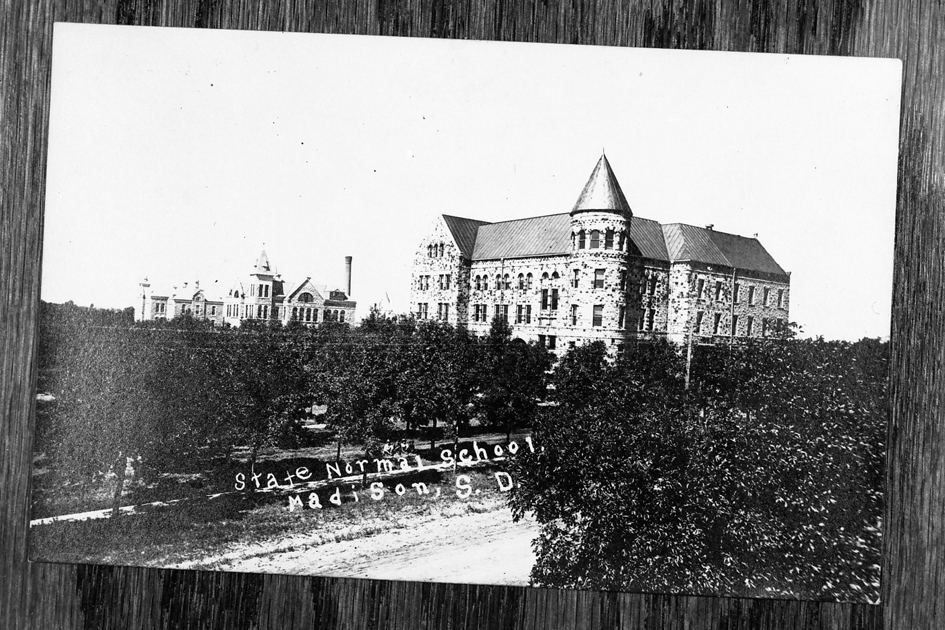
-
1881 – Dakota State University is located in the ancestral territory of the Oceti Sakowin, an alliance made up of the Isanti, Ihanktunwan, and Titunwan. Today, these peoples are represented by the nine federally recognized tribes of South Dakota: The Cheyenne River Sioux Tribe, Crow Creek Sioux Tribe, Flandreau Santee Sioux Tribe, Lower Brule Sioux Tribe, Oglala Sioux Tribe, Rosebud Sioux Tribe, Sisseton-Wahpeton Oyate, Standing Rock Sioux Tribe, and the Yankton Sioux Tribe. Dakota Normal School at Madison, Dakota Territory was authorized by Territorial Legislature on March 5. The school utilized 20 acres of land donated by Mr. C.B. Kennedy. The deed stipulated if the land were ever used for anything but its original intent (a teacher’s preparation institution) or discontinued, the site would be returned to the Kennedy estate.
- 1883 – started with 11 enrolled on December 5, with Professor Charles S. Richardson, first President (1883-1887). Classes were held in local buildings.
- 1884 – Appropriations secured, and construction begins on first college building – 50 x 70 feet, three stories, wood-frame structure. Enrollment was up to 70.
- 1885 – School moved into a new wooden building with 107 students. The Model School was established for teacher education, one of the first laboratory schools in the nation. West Hall Dormitory was built; it was 36 x 86 feet and housed 70 students.
- 1885 – The first graduating class consisted of two students.
- 1886 – Beadle Hall opened in September of 1886. It is the oldest building in the state still used for its original purpose.
- 1886 – The school’s classroom building burned to the ground three months after it was completed.
- 1887 – William F. Gorrie, President (1887-1889), second President.
- 1887 – 400 trees were planted on campus for Arbor Day.
- 1888 – The Commercial Department (business training) was introduced. It was housed on the third floor of Beadle Hall, with a skylight for good lighting.
- 1889 – South Dakota gained statehood in February. All state institutions were placed under the Board of Regents (BOR). General William Henry Harrison Beadle became the third President (1889-1905). There were 191 students enrolled in the Normal Dept.
1890s
- 1892 – “The Oyaka” was the first college paper (September 1892). The name was derived from the Dakota Indians, meaning, “messenger of herald.”
- 1895 – The three-year elementary course was extended to four years and the first-year elementary courses were extended to one and a half years of attendance.
- 1898 – The first summer school sessions were introduced at the normal school. Eight-week sessions were offered to the students.
- 1898 – 2,000 trees were planted by townspeople.
1900s
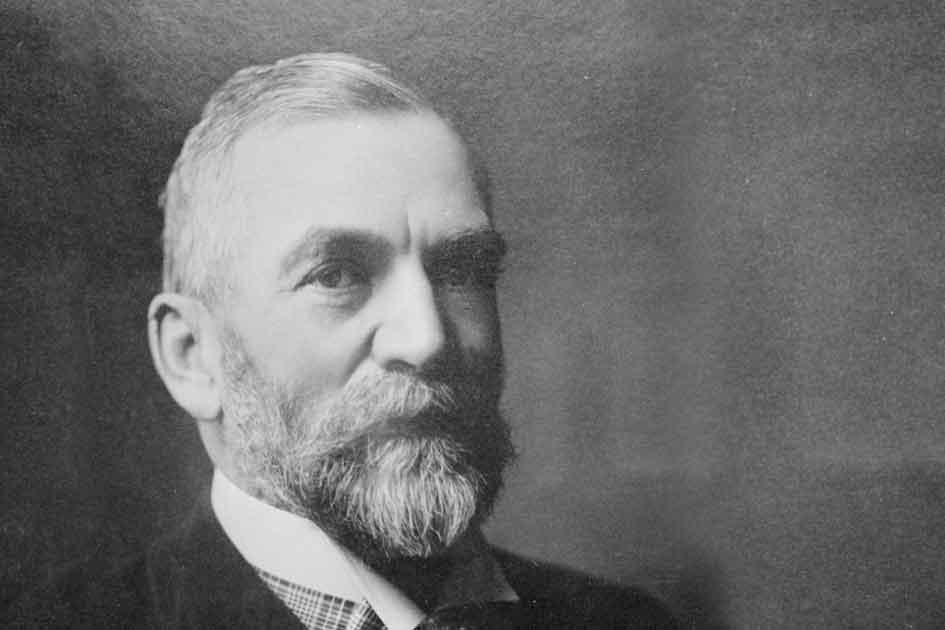
- 1901 – President Beadle went on a year’s sick leave to regain his health. Professor William W. Girton was selected as Acting President (1901-1902).
- 1901 – East Hall was built as a women’s dormitory in 1901. The granite building was heated by steam and lighted with incandescent electric lamps.
- 1902 – President Beadle returns as President. First graduating class to wear cap and gowns. Name changes to Madison State Normal School.
- 1904 – East Wing (later called Kennedy Hall) was constructed, made of Dell Rapids’ granite.
- 1905 – The first year the “Anemone” (college yearbook) was published. President Beadle retires as president, but stayed on as a professor of history, until 1912 when he retired. John W. Heston was President from 1905-1920.
- 1905 – At this time, property, buildings, and equipment were valued at $140,000.
- 1909 – The long-abandoned West Hall was torn down to make way for the Science Hall, now the Tunheim Classroom Building.
- 1910 – The Science Hall was built, including the gymnasium. It was later called the Women's Gym and Performing Art Center. Later it became known as the Tunheim Classroom Building.
- 1914 – By this date, there were four buildings on campus, and all had electric lights courtesy of the campus central heating plant, called the Power House.
1910s
- 1910 – Erection of Science Hall (gymnasium, later called Women’s Gym and Performing Art Center), now called Performing Arts Center.
- 1912 – First year of inter-collegiate athletic competition.
- 1917 – Campus Laboratory School built. It was a one-story brick building with a basement. It was an excellent teacher-in-training laboratory facility.
1920s
- 1920 – Bela M. Lawrence was appointed as Acting President (February to July 1921). Edgar C. Higbee (1920-1931) was selected as President in 1920 but didn’t take office until the fall of 1921. Madison Community Hospital (Heston Hall) was opened to the public on August 1, 1920.
- 1921 – Edgar C. Higbee (1920-1931) took office in the fall of 1921, and the name Eastern State Normal School was officially adopted. The state of South Dakota acquired houses and lots to be used for dormitory purposes (overflow from East Hall). One was named “Girton House” after W.W. Girton, who began his work here in 1896 as a secretary and instructor, and later as Professor William W. Girton, and as Acting President from 1901-1902.
- 1922 – Pioneer Day, a Homecoming Day celebration, was inaugurated.
- 1922 – Kappa Sigma Iota was organized.
- 1922 – A student health service was organized with R.S. Westaby as the first school doctor. He was also one of the hospital administrators.
- 1922 – The athletic teams were called “Warriors,” or "Teachers." The name “Trojans” came from a 1928 contest, won by Ray Kellogg ‘31.
- 1923 – Pioneer Day was changed to Eastern Frontier Day.
- 1923 – The Garden Theater was built on the west side of campus for $5,000. It could hold 2,000 people for graduations and other events, weather pending. This is now the site of the Madison Cyber Labs.
- 1924 – The first Student Senate was organized in 1924-25, to offer a student voice in matters pertaining to student problems confronting the administration of the school.
- 1925 – Eastern Frontier Day changed to Eastern Day.
- 1927 – Name was changed to Eastern State Teacher’s College. The first football game was played on the campus athletic field.
- 1929 – Senior student Barrett Lowe’s film “Dacotah” debuted on October 19, 1929. It was the first all-college picture of its kind filmed in the US.
1930s
- 1931 – E.A. Bixler was Acting President from 1931-1933. Eastern State Normal School dropped back to a two-year college.
- 1933 – V.A. Lowry was President from 1933-1962.
- 1936 – Faculty member Gertrude Gill wrote a curriculum book titled “How to Teach Poetry.” The Karl Mundt Library has several copies, some available for checkout.
- 1937 – Statue of General W.H.H. Beadle erected on campus, a contribution from alumni, faculty, and friends.
- 1937 & 1938 – Beadle Centennial Celebration, sponsored by the South Dakota Education Association.
1940s
- 1941 – A sundial in memory of Claude Tyrrell, Superintendent of Buildings, was put up on campus, a year after he suffered a fatal accident while on duty.
- 1945 – The Homecoming football game was played with two all-female teams, as there were not enough men back on campus after the war to field a team.
- 1946 – Eastern State Normal School returned to a four-year degree program.
- 1947 – Name changed to General Beadle State Teachers College.
1950s
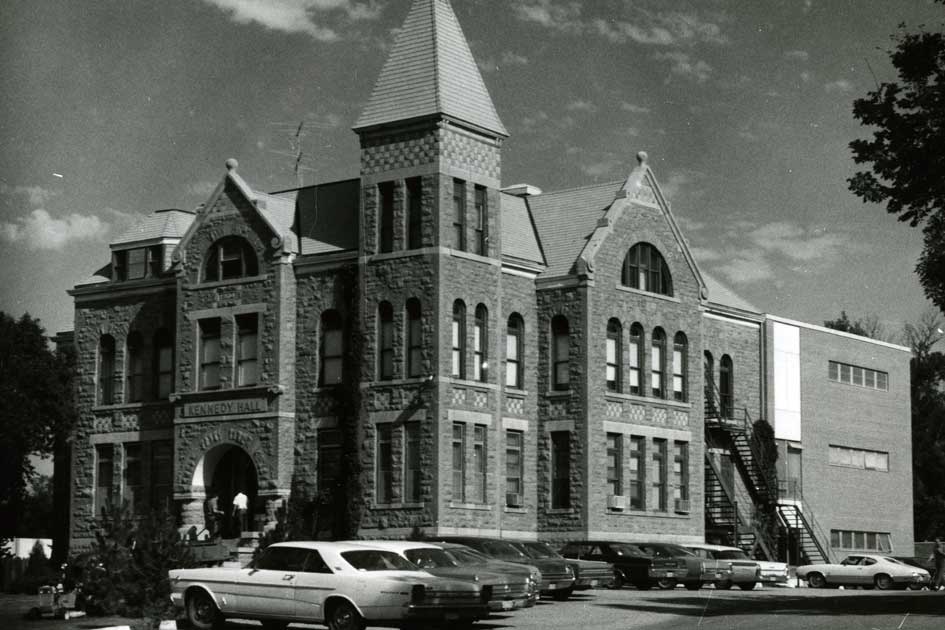
- 1954 – George Smith donated the Deagan Celesa Chimes.
- 1955 – East Wing was renamed Kennedy Hall in honor of C.B. Kennedy, the donor of the original 20-acre college site. “Kennedy Hall” sign donated as a memorial to Mr. Ernie MacDonald, who served as East Hall steward for many years. Eastern Day was renamed Tutor Day.
- 1957 – 24.81 acres of additional land was purchased for expansion of the college, three blocks north of the present campus.
- 1958 – Lowry Hall (for men) was completed, named after former President V.A. Lowry. Property, buildings, and equipment were valued at almost $3 million.
1960s
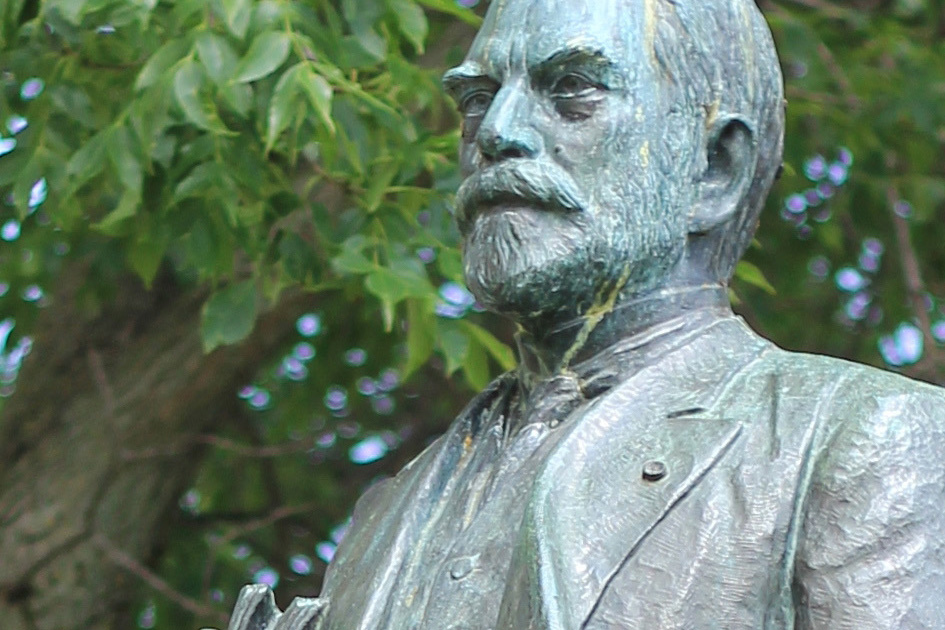
- 1960 – Memorial Gym and the Fieldhouse were completed, built in conjunction with the National Guard.
- 1961 – The Lake County Historical Museum was built on campus and donated to the State of South Dakota by George G. Smith and Lillian Zimmerman with a $75,000 initial donation, and $16,000 additional.
- 1962 – Dr. Laurence Samuel Flaum was President from 1962-1967.
- 1963 – Campus School (Beadle High School) was destroyed by fire on January 19, leaving 350 students without a school.
- 1964 – Name of College changed to General Beadle State College. Zimmermann Hall was built.
- 1965 – Trojan Center and Higbee Hall were built.
- 1966 – In 1966-1967, the Trojan basketball team compiled the best record in school history, with 20 wins and 6 losses in the season.
- 1967 – Dr. Harry Pitkin Bowes was President from 1967-1971.
- 1968 – New Trojan Field was built north of the main campus.
- 1969 – Name changed to Dakota State College. Karl E. Mundt Library was dedicated in June, with President Richard Nixon here for the dedication.
1970s
- 1970 – Richardson Hall was built.
- 1971 & 1972 – Dr. Allen R. Miller was Interim President.
- 1971 – Heston Hall, the former Madison Hospital, was ready for use after renovation.
- 1972 – Ruth C. Habeger Science Center was built.
- 1972 to 1974 – Dr. Francis Gordon Foster was President from 1972-1974.
- 1974 – Dr. Richard Bowen was President of DSU and USD from 1974-1976.
- 1975 – Health Information Management program began.
- 1976 to 1977 – Dr. Robert H. DeZonia was Acting President from 1976-1977, followed by Charles Lein, who was President from 1977-1978.
- 1978 to 1983 – Dr. Carleton M. Opgaard, President
1980s
- 1980 – KDSU broadcast system on campus began.
- 1983 – The Deagan Celesa Chimes were replaced in 1983 by Schulmerich Quadrabell Chimes, donated by Della Cassutt and Ed Marquart.
- 1983 – Kennedy Hall closed as a portion of the east wall was damaged by lightning.
- 1984 – On February 29, 1984, the state legislature passed a bill changing DSU’s mission to include instruction of computer-related technology in all majors.
- 1984 – Dr. Richard J. Gowen was President from 1984-1987.
- 1987 – Dr. Jerald A. Tunheim was President from 1987-2004.
- 1987 – New Kennedy Center dedicated on October 16.
- 1989 – Name changed to Dakota State University.
1990s
- 1991 – Dakota Prairie Playhouse completed to serve as a theater/conference center.
- 1998 – YAHOO magazine recognized DSU as 12th in the nation for being "most wired." In 1999, Yahoo! Internet Life ranked DSU as 10th most wired in the nation.
- 1999 – The North Central Association of Colleges and Schools (NCA) extended DSU's accreditation to include the Master of Science in Information Systems (MSIS).
2000s
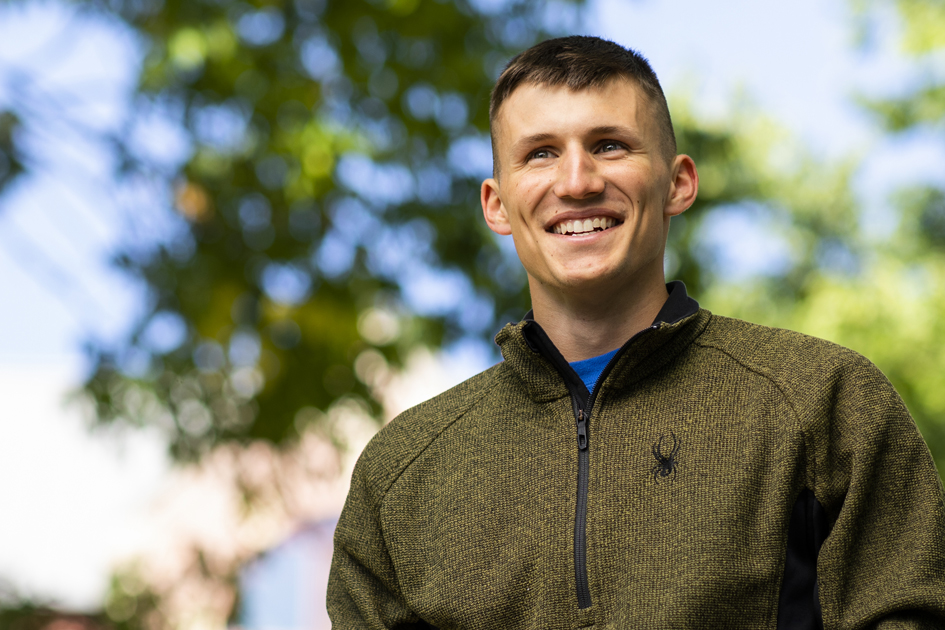
- 2000 – YAHOO magazine recognized DSU as 9th in the nation for being wired.
- 2000 – Madison Community Center opened, a joint recreation building for use by campus and the Madison community.
- 2000 – The Master of Science in Education in Computer Education & Technology was accredited by the NCA.
- 2001 – 97 courses were offered by distance education.
- 2001 – Eight-Plex housing built north of campus.
- 2002 – DSU was the first state university in South Dakota to have multiple-building wireless technology.
- 2002 – DSU was named 3rd in US News & World Report Top Midwestern Public Comprehensive Colleges, and on the list of "Best Online Graduate Degree Programs."
- 2003 – DSU Champion Scholarships were first offered. The original idea was a $1,000 scholarship award, based on an incoming freshman’s ACT and high school GPA. It was renewable for four years if the student maintained a certain GPA in college.
- 2004 – The NSA and DHS designate DSU as a Center of Academic Excellence in computer security.
- 2004 – DSU received accreditation for the new Master's in Information Assurance, and a new degree in Scientific Forensic Technology.
- 2004 – Dr. Jerald Tunheim retired after 17 years as President and was succeeded by Dr. Doug Knowlton.
- 2004 – DSU went completely wireless across campus. Incoming freshman and full-time sophomore students received Gateway M275 tablet PC computers.
- 2005 – DSU installed the Walk of Honor on the west edge of campus to honor donors.
- 2005 – The Doctor of Science degree in information systems approved by Board of Regents (BOR).
- 2006 – DSU celebrated its 125th year with a series of celebrations throughout the year. The university also published a commemorative book.
- 2006 – DSU ranked #1 public baccalaureate college in the Midwest in the annual US News & World Report survey.
- 2009 – The Tunheim Classroom Building was dedicated in September. It was named for Jerald Tunheim, DSU’s 20th president who served from 1987-2004.
- 2009 – DSU established the Center for the Advancement of Health Information Technology (CAHIT).
2010s
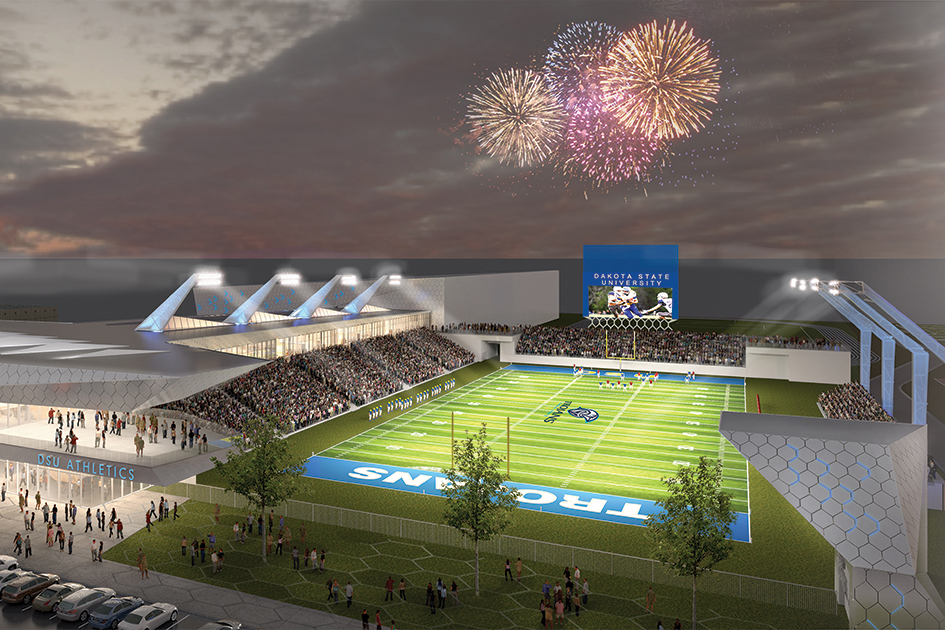
- 2010 – DSU’s Doug Knowlton became the first president of a public university in South Dakota to have an active Twitter account.
- 2012 – Dr. Knowlton left and was replaced by Dr. David Borofsky (2012-2014).
- 2013 – DSU received a $5 million gift from alumnus Miles Beacom and philanthropist T. Denny Sanford. It was the largest private gift in the school's history. At the time, the gift was intended to help renovate the Madison Community Hospital into a planned Beacom Institute of Technology building. The hospital was instead renovated into a residence Hall (Courtyard Hall) and student service offices, and the Beacom Institute of Technology was built next to Heston Hall.
- 2014 – Dr. Maryz Rames became the interim president from 2014-2015.
- 2014 – DSU receives a $5 million gift from Miles Beacom and T. Denny Sanford. The money was used to establish the Beacom Institute of Technology. This was the largest private gift in the school’s history.
- 2015 – Dr. José-Marie Griffiths became the 23rd DSU President.
- 2017 – Trojan Center and Learning Engagement Center are remodeled.
- 2017 – Hope Juntunen was named a Goldwater Scholar, the first DSU student so honored.
- 2017 – The University celebrated the grand opening of the Beacom Institute of Technology with a community party, featuring a concert by country music star Jake Owen.
- 2017 – Miles and Lisa Beacom and T. Denny Sanford announced a $30 million gift to Dakota State that will be used to construct the Madison Cyber Labs, or MadLabs®, provide for scholarships and faculty and staff development and develop programs. The gift also allows for the computer college to be renamed The Beacom College of Computer & Cyber Sciences.
- 2018 – DSU was named the #3 cybersecurity school by Military Times.
- 2018 – DSU instituted a new Workforce Development Alliance with Madison Regional Health. This will allow the partner to underwrite a portion of the student's educational costs and provide internship opportunities during college in exchange for employment commitment from the student.
- 2018 – Lowry Hall was demolished to make room for the new Madison Cyber Labs construction.
- 2018 – Vaille Swenson has been named a Goldwater Scholar. She is the second DSU student in two years to earn this honor.
- 2018 – The statue of General Beadle and the World War I memorial were moved from their location near Lowry Hall, where they had been since 1933. The move was in preparation for the demolition of Lowry Hall. The World War I memorial was moved to the Rose Garden, and the Beadle Statue to the central campus just north of the Tunheim Classroom Building.
-
2018 – The number of women enrolled in The Beacom College is up almost 300% in the past five years, due in part to efforts of the outreach program CybHER.
-
2018 – President Griffiths was invited to attend a first-of-its-kind State-Federal Science, Technology, Engineering, and Math (STEM) Education Summit hosted by the White House Office of Science and Technology Policy.
-
2018 – DSU hosted a Q&A session with the International Space Station.
-
2018 – The Continuous Quality Improvement (CQI) committee created the annual Knowlton Excellence in Quality award for the best CQI project. The first award went to the International Department for a free transportation service for students. This CQI program was implemented by former President Doug Knowlton.
-
2018 – DSU becomes the first institution in the state to offer an online Elementary Education degree.
-
2018 – President Griffiths was named to the National Security Commission on Artificial Intelligence.
-
2019 – Campus Watch was created to increase campus security presence during the evening hours with employees each evening providing safe chaperone services for students, staff, and faculty members.
- 2019 – Dakota State joined the collegiate world of esports. Esports is a non-seasonal sport in which a variety of computer video games are played by junior varsity and varsity teams. This makes 13 teams for the Athletics Department.
- 2019 – DSU carries out its first “DSU Giving Day” on March 22. This was a 24-hour giving campaign that inspired alumni, students, friends, faculty, and staff, and supporters to Rise UP together, show pride in their alma mater, and provide essential funding to support current and future students. This has become an annual event.
- 2019 – Dr. Clyde Brashier became the first inductee into the DSU Academic Hall of Fame.
-
2019 – DSU student Carl Peterson received a $10,000 Dreamstarter grant offered through Running Strong for American Indian Youth. He used the grant to develop his own game design company, Northern Plains Game Design.
-
2019 – The South Dakota Advantage is announced, a tuition program that states public universities offer new freshman and new transfer students from Wyoming, Montana, North Dakota, Nebraska, Iowa, and Colorado to give them a tuition rate equivalent to the resident undergraduate rate.
- 2019 – Dakota State introduced two new telepresence robots, Dewey and Cosmo. These robots allow students, faculty, or staff to remotely attend meetings or classes.
- 2019 – First PREMIER Bank/PREMIER Bankcard, along with Miles and Lisa Beacom, made a lead gift of $10 million towards the Trojans Unite Capital Campaign. This gift launched the $42 million Phase I portion of the campaign, which will feature a new two-story concourse and outdoor facilities for DSU Athletics.
- 2019 – The Karl Mundt Library celebrated the 50th anniversary of its dedication.
-
2019 – Dr. Ashley Podhradsky was selected as one of 125 IF/THEN Ambassadors with the American Association for the Advancement of Science.
- 2019 – The General Beadle statue is placed in its permanent home near the Tunheim Classroom building and the WWII Memorial is placed just south of the campus rose garden.
-
2019 – The Madison Cyber Labs (MadLabs®) was formally dedicated on October 2, 2019. This location will provide faculty, students, and researchers with space, technology, and infrastructure to support exploration in cyber-related areas.
2020s
-
2020 – Miss America visited campus; DSU has become a sponsor of the organization, offering scholarships to study STEM.
-
2020 – After spring break, the DSU campus moved to all online classes for the spring semester, in response to the COVID-19 pandemic. On-campus classes resumed in the fall, along with a number of mitigation protocols.
-
2020 – DSU student researchers confirmed Aphanomyces (root rot) in alfalfa in South Dakota.
-
2020 – Dakota State and Sanford Health announce a CyberHealth Strategic Alliance, to partner on innovation and research, and create workforce and economic development opportunities.
-
2020 – Dr. Zeno Van Erdewyk was named to the Academic Hall of Fame.
-
2020 - DSU’s Health Information Technology program celebrated 45 years since the creation of the program’s first associate degree.
-
2020 – Dakota State and Sanford Health announced a CyberHealth Strategic Alliance to partner on health-related innovation and research, and create workforce and economic development opportunities.
-
2021 – DSU Cyber Operations student Gabe Lamb was chosen for the US Space Force.
- 2021 – DSU received its first provisional patent, through the efforts of Dr. Justin Blessinger, who developed an assistive technology device for individuals in powered wheelchairs and scooters.
-
2021 – The University welcomed a new mascot to the Trojan Family, General Cyber.
-
2021 – DSU opened the Entrepreneurial Building, including the Paulson Cyber Incubator and Entrepreneurial Center.
-
2021 –DSU launched the “Cyberology” podcast, about all things cyber and technology.
-
2021 – Dr. Ashley Podhradsky was one of 125 Women in STEM honored with a life-size statue, displayed around the country.
-
2021 – The Board of Regents approves two new DSU degrees, in Artificial Intelligence, and Artificial Intelligence for Organizations.
-
2021 – President Griffiths has been named to the CNAS AI Task Force.
-
2021 – DSU welcomed a new mascot, General Cyber.
-
2021 – Four Dakota students and alumni have been named to the first-ever US Cyber Games team. This team competed in Season I of the International Cybersecurity Competition in 2022 in Greece.
-
2021— The Forum on History and Ethics has been created, to bring speakers to campus to consider how history and ethics relate to technology. The first speaker was Dr. Bradley Birzer.
-
2021 - DSU Esports hosted the first Midwest Invitational.
-
2022 – Dakota State announced a $90 million cyber-research initiative, the result of collaborations between several public/private partners. This game-changing vision will help make South Dakota a cyber state.
-
2022 – Dakota State was named to the US Cyber Command Academic Engagement Network.
-
2022 – The Trojans Unite Comprehensive Campaign was launched, with the goal of raising $250 million for athletics, cyber-research, and academic success. Ground-breaking for Phase I of the athletics expansion took place on May 2.
-
2022 – Dakota State joined an international consortium with AI Sweden. The Edge Learning Lab will research technology in this critical growth area.
-
2022 – A grant from AT&T allowed CybHER to take cyber education outreach to the South Dakota reservations.
